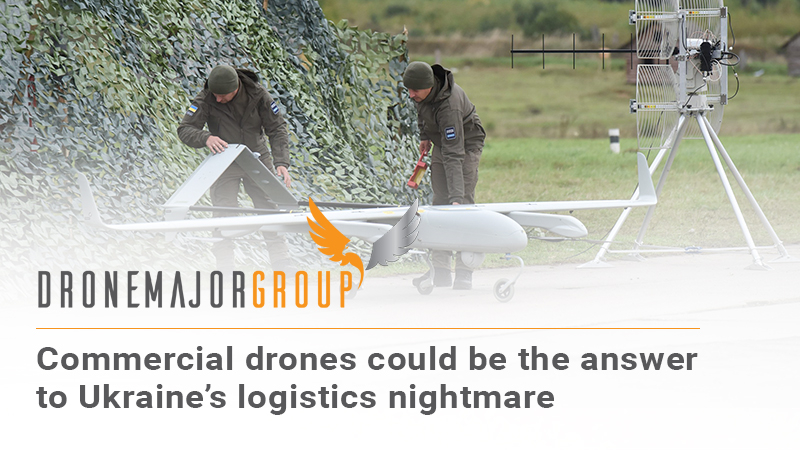Drone Major introduces significant client to Drone Evolution
Words By: Drone Major
Editorial Feature
Words By: Robert Garbett
Since the start of the conflict in Ukraine, unmanned air systems (UAS), otherwise known as drones, have played an important role in the defense of the country against Russian aggression.
Whether it’s military offensive systems delivering devastating effects on advancing Russian convoys or small drone camera systems providing reconnaissance, air drones have undoubtedly been instrumental in enabling the Ukrainian military to mount an effective defense against the Russian invasion.
However, their true potential to support what every war veteran knows can win or lose a war–logistics–is yet to be unleashed.

We are missing a huge opportunity to provide a more diverse range of technological solutions which will be a deciding factor in what is now a battle of attrition: using heavy-lift commercial drones for the delivery of supplies into areas cut off by Russian forces.
In any war, food, fuel, ammunition, and medical re-supplies to frontline troops and besieged civilians are critical to success. With more than 100,000 people still trapped in areas dominated by Russian forces, delivering these key resources quickly, regularly, and without further risk to human life is a must.
In many areas, delivering supplies by rail, road, or traditional air transport is either extremely risky or impossible due to military activity. Every day, volunteers risk their lives to deliver supplies to Ukrainian frontline forces or beleaguered civilians, and sadly, many give their lives in doing so.
There has to be a better way.
We know that Russian forces will shoot down everything they see in the air but by bringing several civilian and commercial technologies into the mix, rather than focussing entirely on the provision of military systems, it is possible to create elusive, shifting supply lines across the country and into hard-to-reach areas.
An army of air drones from a range of global manufacturers can deliver a range of cargo from 20kg to 500kg of critical supplies to locations across Ukraine. With a huge range of fixed-wing, rotary-wing, gyrocopter, and hybrid aircraft operating in a coordinated network of short and long-range supply lines, we could provide an almost inexhaustible supply of anything that front line forces or trapped civilians might need without risking a single human life.
Flying at night, close to the ground, and employing specialist technology to allow flights in areas where Global Navigation Satellite Systems (GNSS) are jammed and coatings designed to significantly reduce radar cross-section, it would be possible to significantly enhance supply lines to frontline locations and Russian-dominated areas. Of course, there would be losses–but replenishing these unmanned vehicles would be rapid and cost effective.
Understandably, Ukrainian requests for air drone technology focus on the need for military-grade offensive systems and small Chinese camera systems because they have been, and continue to be, effective in a rapidly moving conflict.
The missed opportunity is that, in the desire to supply Ukraine with what it is asking for, it seems no one is considering alternative methods for turning the tide against Putin’s aggression.
Drones could be used in a myriad of ways: Fast-moving, quiet air drone systems can be used in electronic warfare to disrupt Russian communications on the ground or confuse Russian aircraft; small systems can be used to deliver passive target acquisition beacons that increase the efficacy of strikes.
More could be done if we think creatively about how we can use drones to help people across Ukraine gain better access to the supplies that nations across the globe have so generously donated.
Coupled with the ingenuity and the determination of the Ukrainian people, I believe that this can make a huge difference in the struggle ahead, keeping frontline forces and trapped civilians supplied. To win the war in Ukraine, we need to focus on logistics, not material.
Robert Garbett is the founder and CEO of Drone Major Group, a London-based drone consultancy business.
This article originally appeared on Fortune.com - https://fortune.com/2022/04/26/commercial-drones-invasion-tech-ukraine-russia-putin-war-logistics-supply-lines-mariupol-civilians-international-robert-garbett/